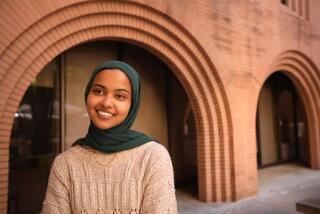More Youngsters in L.A. County Living in Poverty
Reversing a longtime downward trend, child poverty is on the rise across Los Angeles County as housing costs spiral out of reach for working-class families, according to a report to be released today.
An estimated three-quarters of the county’s more than 1.2 million households with children struggle economically, according to this year’s Children’s ScoreCard, released every two years by the Los Angeles County Children’s Planning Council. The cost of living has spiked more than 40% since 1999, as the county’s median wage inched up to $15.28 last year.
Many parents are forced to live in less safe but more affordable neighborhoods, jam several families into a single residence or work several jobs to pay the rent. Just 14% of county households could afford to buy a home in 2005, compared with 50% nationwide. And while 11% of Westside rental units are overcrowded, two-thirds of rentals in Bell Gardens, South El Monte and Lennox were packed with too many residents. As a result, children suffer as they grow up in low-income households.
“We’ve set it up for these kids to fail,” said Yolie Flores Aguilar, chief executive officer of the council.
The study tracks recent statistics that offer a sketch of the county’s families.
Underscoring long-standing geographic disparities, data show that children in the dense urban neighborhoods of Central and South Los Angeles continue to live in the toughest economic conditions while Westside families enjoy relative prosperity.
Yet family incomes are suffering countywide; the study “lays bare the reality that poverty is afflicting every geographic community of Los Angeles,” said Supervisor Zev Yaroslavsky, chairman of the council.
Latino and African American children still lag behind whites and Asians in health and education indicators.
African American children are more likely to be born underweight or with asthma, or to be arrested, than peers of other ethnicities. More Latino children come from low-income families than other groups, have the least-educated parents and are the worst-prepared for college. Asian youngsters perform the best in education measures, while white children fare better economically.
“There’s a strong correlation between race and how well kids are doing across the county,” Flores Aguilar said. She emphasized the “ripple effects” of poverty, which can undermine a child’s health, performance at school and eventual success as an adult.
Although more children than ever -- 92% -- are insured, the number of underweight babies has been climbing since 2000, the report said.
Violent crime as well as child abuse and neglect are down since 2000, but juvenile felony arrests and youth homicides increased after years of decline.
And while the percent of fully credentialed teachers rose by nearly a fifth since 2000, high school graduation rates have been slipping.
While the number of computers being placed in public schools has jumped 72% in four years, the number of library books checked out by children and teens is falling.
For the first time, the study incorporated the comments of residents from 64 community forums.
Residents’ observations showed, “It is getting increasingly difficult to raise children in Los Angeles,” said Jacquelyn McCroskey, a USC professor of social work who helped compile the statistics.
susannah.rosenblatt@latimes.com
*
(BEGIN TEXT OF INFOBOX)
Comparing the well-being of the county’s children
The biennial Children’s ScoreCard for 2006 examines the condition of Los Angeles County’s children in terms of indicators measuring health, safety, education, economic status and social and emotional well-being. The full report can be found at www.childrensplanningcouncil.org. Here are some of the findings in each of the county’s eight “service planning areas,” shown below.
Facts at a glance
1. Antelope Valley
- Highest percent of children with asthma
- Lowest percent of college-prepared graduates
- Highest percent of students fluent in English
2. San Fernando
- Lowest juvenile felony arrest rate
- Highest percent of fully credentialed teachers
3. San Gabriel
- Lowest child death rate due to accidental injuries
- Highest public high school graduation rate
4. Metro
- Lowest percent of students fluent in English
- Lowest percent of children exposed to tobacco smoke at home
- Lowest number of students per computer
5. West
- Highest percent of children with health insurance
- Lowest infant and child death rates
- Lowest number of youth homicides
6. South
- Lowest percent of children with health insurance
- Highest infant and child death rates
- Largest number and highest rate of youth homicides
7. East
- Lowest percent of low-weight births
- Lowest infant death rate
8. South Bay/Harbor
Highest percent of children who can easily access a safe play place
---
Within walking distance of a park (1/4 mile)
Compared to some other major cities, relatively few Los Angeles children live within walking distance of a park.
Boston: 97%
New York: 91%
San Francisco: 85%
Seattle: 79%
San Diego: 65%
Dallas: 42%
Los Angeles: 33%
Los Angeles County: 36%
---
Students per academic counselor (2004-05)
High schools in the Antelope Valley have the most students per academic counselor. The schools in the Metro area have the least.
Antelope Valley: 533
San Fernando: 391
San Gabriel: 480
Metro: 339
West: 387
South: 414
East: 486
South Bay/Harbor: 427
---
Source: Los Angeles County Children’s Planning Council
More to Read
Start your day right
Sign up for Essential California for news, features and recommendations from the L.A. Times and beyond in your inbox six days a week.
You may occasionally receive promotional content from the Los Angeles Times.






